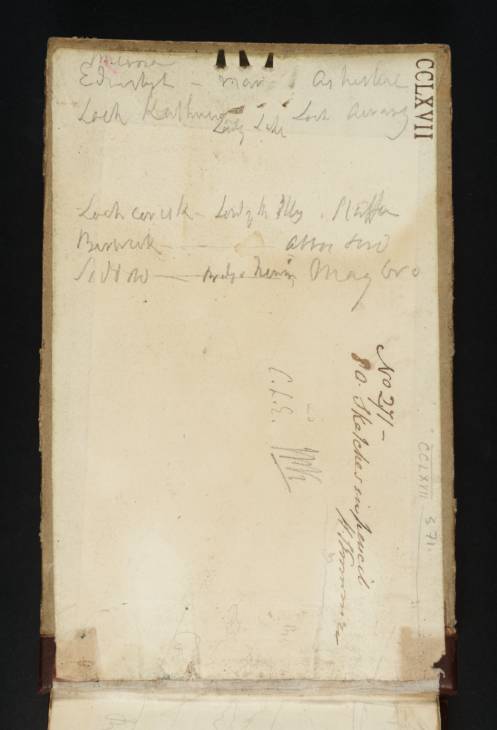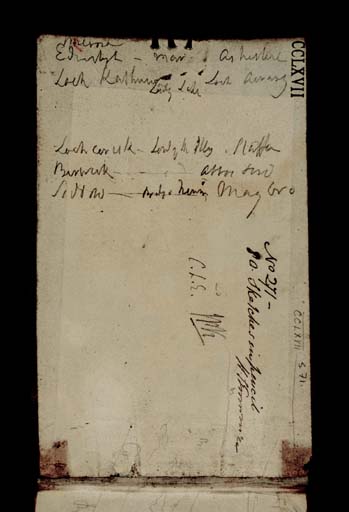J.M.W. Turner
>
1830-35 Annual tourist
>
Scotland 1831
>
Abbotsford Sketchbook
>
Artwork
Joseph Mallord William Turner Notes on Scottish Itinerary 1831
Image 1 of 2
Inside front cover of sketchbook
Joseph Mallord William Turner,
Notes on Scottish Itinerary
1831
(Inside front cover of sketchbook)
Joseph Mallord William Turner 1775–1851
Inside Front Cover:
Notes on Scottish Itinerary 1831
D40995
Pencil on off-white wove writing paper, 182 x 111 mm
Inscribed in pencil by Turner from the top of the page
And at the bottom of the page ‘Br’ and [?]‘Cur’ descending vertically
Inscribed in brown ink by H.S. Trimmer ‘No 271 – | 80 sketches in pencil. | (signed) H.S. Trimmer’ right descending vertically
Inscribed in pencil by Charles Lock Eastlake ‘C.L.E.’ and by John Prescott Knight ‘JPK’ beneath Trimmer’s inscription descending vertically
Blindstamped with the Turner Bequest stamp centre
Inscribed in pencil by Finberg ‘CCLXVII 571’ top right descending vertically
Inscribed in pencil by Turner from the top of the page
And at the bottom of the page ‘Br’ and [?]‘Cur’ descending vertically
Inscribed in brown ink by H.S. Trimmer ‘No 271 – | 80 sketches in pencil. | (signed) H.S. Trimmer’ right descending vertically
Inscribed in pencil by Charles Lock Eastlake ‘C.L.E.’ and by John Prescott Knight ‘JPK’ beneath Trimmer’s inscription descending vertically
Blindstamped with the Turner Bequest stamp centre
Inscribed in pencil by Finberg ‘CCLXVII 571’ top right descending vertically
Accepted by the nation as part of the Turner Bequest 1856
References
1909
A.J. Finberg, A Complete Inventory of the Drawings of the Turner Bequest, London 1909, vol.II, p.857.
Turner first opened the current sketchbook at Abbotsford, the home of Sir Walter Scott, where the artist stayed with the author and his publisher Robert Cadell from 4–9 August 1831. These inscriptions, written at the top of the page with the sketchbook turned to the right, were probably the first thing that Turner wrote in the book:
Melrose
Edinburgh – Mar – Ashestiel
Loch Katrine Lady Lake Loch Achray
Edinburgh – Mar – Ashestiel
Loch Katrine Lady Lake Loch Achray
Loch Corisk – Lord of the Isles, Staffa
Berwick --------------------------- Abbotsford
S[k]iddaw – Bridal of Triermain Maybro
Berwick --------------------------- Abbotsford
S[k]iddaw – Bridal of Triermain Maybro
The inscriptions were no doubt made during or shortly after his conversation with Scott and Cadell on the morning of 5 August, which was about the subjects to be illustrated by the artist for Scott’s Poetical Works. Many of the subjects had already been fixed upon by Scott and Cadell during previous meetings and through correspondence; however, with the artist now present, adjustments were made.1 Cadell wrote about the meeting in his diary entry for that day.2
Turner’s notes list some of the subjects and the volumes which they were to be illustrated for, with the frontispiece in the left column, the book in the centre, and the vignette at the right. Therefore ‘Edinburgh’ and ‘Ashestiel’ are the frontispiece and vignette to the ‘Mar[mion]’ volume (7); ‘Loch Katrine’ and ‘Loch Achray’ illustrate ‘Lady of the Lake’ (8); ‘Loch Cor[u]isk’ and the Isle of ‘Staffa’ illustrate ‘Lord of the Isles’ (10); ‘Berwick’ and ‘Abbotsford’ illustrate the Dramas (12); and ‘Skiddaw’ and ‘Maybro’ (Mayburgh)3 illustrate the ‘Bridal of Triermain’ (11). Turner also notes ‘Melrose’, but makes no mention of the remaining thirteen subjects.4
At the bottom of this page is the slight continuation of a sketch of the River Tweed with Dryburgh Abbey from folio 1 (D25929; CCLXVII 1). Other inscriptions on the present page are the endorsements of Turner’s executors: H.S. Trimmer, Charles Lock Eastlake and John Prescott Knight. These inscriptions were written in 1856, and the stamp and Turner Bequest number were added by A.J. Finberg around 1909.
Thomas Ardill
September 2009
Gerald Finley has written an account of the selection of these subjects in Landscapes of Memory: Turner as Illustrator to Scott, London 1980, pp.85–6, 240–44 Appendix 3.
Robert Cadell, ‘Abbotsford Diary’, Friday 5 August 1831, National Library of Scotland, MS Acc. 5188, Box 12, folio 104; transcribed in Gerald E. Finley, ‘J.M.W. Turner and Sir Walter Scott: Iconography of a Tour’, Journal of the Warburg and Courtauld Institutes, vol.35, 1972, p.378.
Mayburgh Henge, described by Cadell in his diary as ‘Maworth’ and referred to in correspondence between Scott and Cadell as ‘Penrith Table’, see Tate D25812 (Turner Bequest CCLXVI 26a).
How to cite
Thomas Ardill, ‘Notes on Scottish Itinerary 1831 by Joseph Mallord William Turner’, catalogue entry, September 2009, in David Blayney Brown (ed.), J.M.W. Turner: Sketchbooks, Drawings and Watercolours, Tate Research Publication, December 2012, https://www


